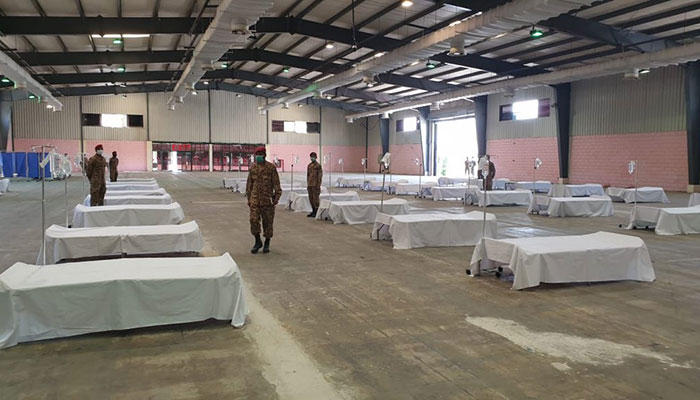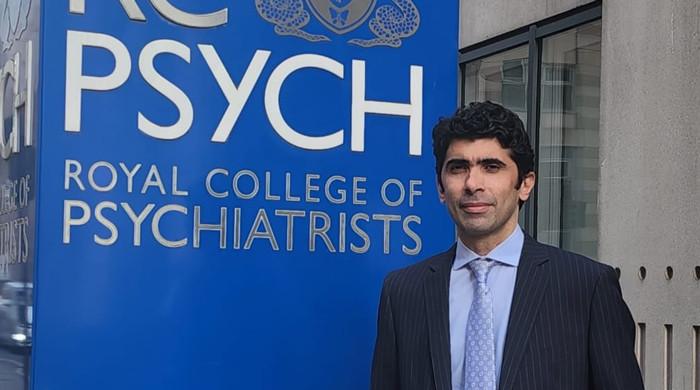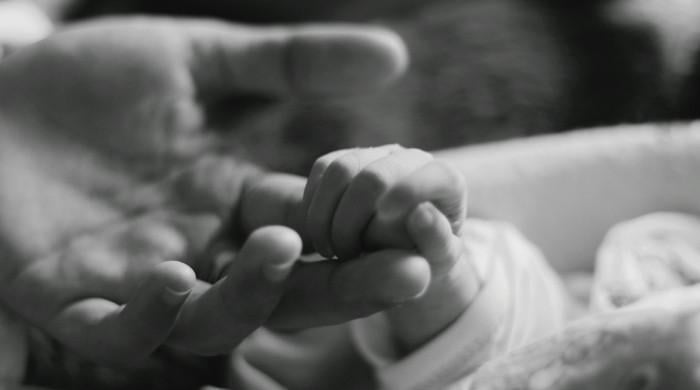COVID-19 pandemic: Expo Centre facility fails to meet expectations with only 87 patients
Sindh government has so far released Rs134 million to the administration of the isolation centre
June 07, 2020

At a time when no space is available for coronavirus patients at any of the tertiary-care hospitals in Karachi, only 87 patients are admitted at the “much-hyped 10,000-bed” field isolation centre established at the Expo Centre, reported The News.
“Since it’s just an isolation centre and not a health facility, they only take asymptomatic patients who are in good health and don’t require oxygen or any other specialised care,” a Sindh government official told The News.
The provincial government has so far released Rs134 million to the administration of the isolation centre, while donors have also provided millions of rupees as well as equipment, machinery and services worth millions of rupees, added the official.
“Of the funds released by the government, hardly Rs47 million has been used. Most of the expenses are being met by the donors who are eagerly providing everything from meals to medicines, mobile phones to X-ray machines, containers for housing and personal protective equipment [PPE].”
Waste of resources?
The isolation centre’s administration said equipment worth millions of rupees, including water purification plants and watches, were provided for patients at the facility, where food was the responsibility of the Saylani Welfare Trust, the Alamgir Welfare Trust and the JDC (Jafaria Disaster Management Cell), while several confectioneries and bakeries provided cakes, sweets and other delicacies.
Dr Farhan Essa, one of the co-founders of the isolation centre and the CEO of Dr Essa Laboratory & Diagnostic Centre, said, “We have set up an Essa lab where all the routine tests are being conducted. AO Clinic owner and Private Hospitals Association President Dr Junaid Ali Shah provided items worth Rs60-70 million, including medicines, beds, PPE and monitors.”
He added the centre also received funding from the World Memon Foundation, and support and items from the Sui Southern Gas Company, the Pakistan Red Crescent Society and many other organisations. Dr Essa said scores of other donors, organisations and institutions were supporting the facility, adding that scouts were performing their duties to maintain inventory and provide food to patients.
‘Failed project’
Officials said the isolation centre that was supposed to be a 10,000-bed facility, as per several announcements of Sindh Chief Minister Syed Murad Ali Shah, and hyped by the government was only a 550-bed facility.
They said that despite spending and having millions of rupees at its disposal, the centre has proved to be a failed project in terms of providing relief to COVID-19 patients who are now running from one place to another in search of hospital beds.
A Pakistan Islamic Medical Association official said, “On several occasions, hospitals treating COVID-19 patients made a request to the Expo Centre’s administration to take patients who are in stable condition and require one to two litres of oxygen so that serious patients could be admitted, but it was flatly refused.”
He added the isolation centre’s administration has so far admitted coronavirus-positive patients who are without any symptoms, have no other medical condition and are below the age of 50, who are less likely to develop any complications and face death.
Terming the facility a “picnic spot”, the official said that at a time when over 80 COVID-19 patients have died in their homes and more than 500 have lost their lives at health facilities across the province, the Expo Centre has reported not a single fatality, which shows that they have only admitted people who have no chance of getting sick during their stay.
He said the money spent on the isolation facility could have been used to develop some tertiary-care health facilities in Karachi, adding that there were several hospitals in the city that were not being used and their buildings could have been upgraded with the millions of rupees that were “wasted on this useless facility”.
Professor Sohail Akhtar, a senior pulmonologist associated with a tertiary-care hospital and dealing with COVID-19 patients, also expressed his disappointment in the isolation centre, saying that the money and resources wasted on it could have been used to upgrade two to three public hospitals in the city where high-dependency units (HDUs) with high-flow oxygen and other therapies could have been made available to save precious lives.
“Hundreds of patients are in self-isolation who need one to two litres of oxygen and some other interventions to save their lives. These patients are also not getting any medical advice. They should be admitted at the Expo Centre and given oxygen and other required therapies so their health doesn’t deteriorate, as no hospital is taking any more patients right now.”
‘Not refusing patients’
The administration of the isolation centre said they were actually a 1,200-bed facility, claiming that they were not refusing any patient. They said that they had different standard operating procedures initially, but now they had an oxygen-dependency unit of 20 beds where those requiring oxygen were being treated.
“We were never a 10,000-bed facility. We have the capacity of only 1,200 beds, and right now we have 87 patients with COVID-19 positive status. We’re taking patients between the ages of 15 and 70 and also accepting patients from hospitals,” said Dr Nuzhat Faruqi, founder and administrator of the isolation centre.
100-bed HDU soon
Dr Nuzhat, who was honoured with the Tamgha-e-Imtiaz for her services in public health, said that after realising the severity of the COVID-19 situation and about the unavailability of beds at tertiary-care hospitals, they had decided to set up a 100-bed HDU where patients requiring oxygen and critical care management would be kept. She said the unit would take some time to set up, as it was currently in the planning phase.
“The number of patients increases and decreases over time. At one time we had over 300 patients, but around Eid the number reduced. We are now gradually getting more patients, and realising the severity of the situation, we have decided to upgrade this facility with the establishment of an HDU for over 100 patients,” she said, adding that when the unit would be established, they would also hire the required specialists and experts to run it.
Originally published in The News











